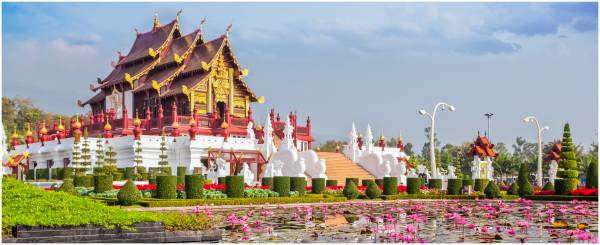Chiang Mai is often referred to as the cultural capital of Northern Thailand, offering a unique blend of ancient traditions and modern attractions. Established in 1296, this historic city is home to over 300 temples, each showcasing exquisite Lanna architecture. Among the most famous are Wat Phra Singh, Wat Chedi Luang, and the hilltop Wat Phra That Doi Suthep, which offers panoramic views of the city.
Beyond its spiritual and architectural treasures, Chiang Mai is known for its vibrant markets, where visitors can explore the local crafts, street food, and bustling atmosphere. The Night Bazaar and Sunday Walking Street Market are particularly popular for their wide variety of goods and lively ambiance.
Chiang Maiís culinary scene is a highlight for many travelers, offering a chance to taste traditional Northern Thai dishes like Khao Soi and Sai Ua (Northern Thai sausage). Cooking classes are also a popular activity, allowing visitors to learn the secrets of Thai cuisine firsthand.
For nature lovers, Chiang Mai serves as a gateway to the surrounding mountains and forests, offering opportunities for trekking, visiting elephant sanctuaries, and exploring hill tribe villages. The city also hosts several festivals throughout the year, including the famous Yi Peng Lantern Festival and Songkran (Thai New Year), adding to its appeal as a culturally rich destination.
With its blend of historical charm, vibrant markets, and natural beauty, Chiang Mai provides a deeply enriching experience for all who visit.
Chiang Mai location & geography
Chiang Mai is located in Northern Thailand, about 700 kilometers (435 miles) north of Bangkok. The city sits in a mountainous region, nestled in a lush valley at an elevation of approximately 310 meters (1,020 feet) above sea level. This geographical setting provides Chiang Mai with a cooler climate compared to the rest of Thailand, especially during the winter months, making it a popular destination for both locals and international tourists.
The Ping River flows through Chiang Mai, adding to the city's scenic charm and playing a vital role in its agricultural prosperity. The surrounding mountains and national parks, such as Doi Inthanon National Park, home to Thailandís highest peak, are easily accessible from the city and offer a wealth of outdoor activities, including hiking, bird-watching, and waterfall exploration.
Chiang Maiís compact city center, surrounded by a moat and remnants of ancient walls, reflects its historical significance as a former capital of the Lanna Kingdom. The cityís strategic location makes it a key hub for exploring Northern Thailand and beyond, with good connectivity by road, rail, and air. The surrounding region is dotted with small villages, forests, and rice paddies, providing a tranquil escape from the urban bustle.
5 fun facts about Chiang Mai
1. Yi Peng Lantern Festival: Every November, thousands of lanterns are released into the sky during the Yi Peng Festival, creating a magical, illuminated night that is iconic to Chiang Mai.
2. Elephant Sanctuaries: Chiang Mai is known for ethical elephant sanctuaries, where visitors can learn about elephant conservation and interact with these majestic animals in a responsible way.
3. Old City Moat and Walls: The historic center of Chiang Mai is surrounded by a moat and remnants of ancient city walls, which were built for protection against Burmese invasions.
4. Hill Tribe Cultures: The surrounding areas of Chiang Mai are home to various hill tribes, such as the Karen, Hmong, and Akha, offering unique cultural experiences and traditional crafts.
5. Coffee Culture: Chiang Mai has a growing reputation for its coffee culture, with many local cafes serving up excellent brews made from beans grown in the nearby mountains.
Last update August 2024

|
TravelXchange.com.au Research * Plan * Share |
About | Contact | Membership | Privacy Policy |


